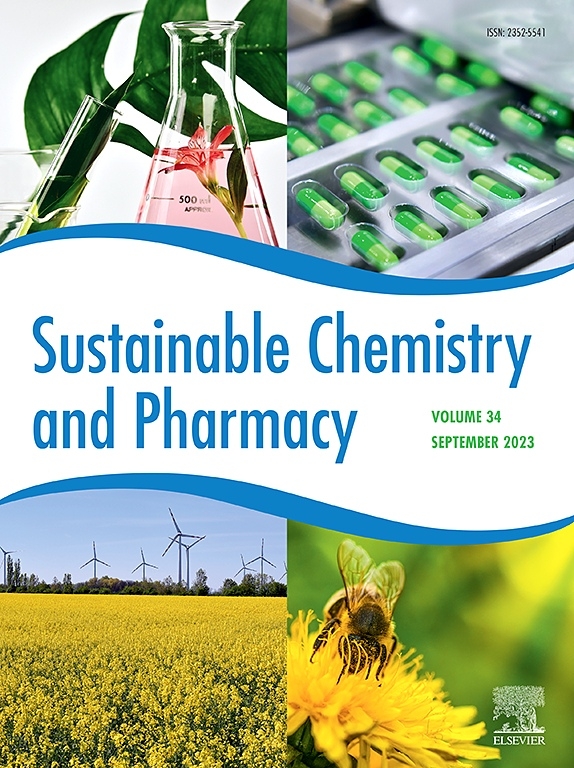New hyper-crosslinked polymers for enhanced CO2 adsorption: Synthesis and characterization
IF 5.5
2区 化学
Q2 CHEMISTRY, MULTIDISCIPLINARY
引用次数: 0
Abstract
In this study, new hyper-crosslinked polymers (HCPs) were synthesized with 3,4,9,10-perylenetetracarboxylic dianhydride (PTCDA) and p-naphtholbenzeine (NB) with different ratios of 4,4′-bis(chloromethyl)-1,1′-biphenyl (BCMBP) through the Fridel-Crafts (FC) method. The polymers were thoroughly characterized by Fourier-transform infrared (FT-IR) spectroscopy, scanning electron microscopy (SEM), Brunauer-Emmett-Teller (BET) surface area analysis, thermogravimetric analysis (TGA), and x-ray diffraction (XRD) confirming the successful synthesis of HCP-PTCDAs and hyper crosslinked p-naphtholbenzein polymers (HCP-NBs). BET analysis revealed that the maximum surface areas of HCP-PTCDA and HCP-NB were 962 m2 g−1 and 665.4 m2 g−1, respectively. The maximum pore volumes of HCP-PTCDA and HCP-NB were 1.26 cm3 g−1 and 1.90 cm3 g−1, respectively. The enhanced surface area and pore volume of HCP-PTCDAs were attributed to the lack of conformational changes in PTCDA during synthesis. The maximum CO2 adsorption capacities of the two polymers were obtained with HCP-PTCDA/20 and HCP-NB/5 (at 273 K and 1 bar: 2.75 mmol g−1 and 3.28 mmol g−1, respectively). Although the surface area of HCP-NB/5 was three times lower than HCP-PTCDA/20, it showed higher CO2 adsorption performance. Accordingly, these results revealed that pore volume and size distribution were one of the most determining parameters in CO2 adsorption. Compared with the literature, the improved CO2 adsorption performance, especially that of HCP-NB/5, showed that these polymers had relatively high potential.

新型增强CO2吸附的超交联聚合物:合成与表征
以3,4,9,10-苝四羧基二酐(PTCDA)和对萘苯(NB)为原料,以不同比例的4,4′-双(氯甲基)-1,1′-联苯(BCMBP)为原料,通过Fridel-Crafts (FC)法合成了新型超交联聚合物(HCPs)。通过傅里叶变换红外光谱(FT-IR)、扫描电镜(SEM)、布鲁诺尔-埃米特-泰勒(BET)表面积分析、热重分析(TGA)和x射线衍射(XRD)对聚合物进行了表征,证实了HCP-PTCDAs和超交联对萘酚醇聚合物(HCP-NBs)的成功合成。BET分析显示,HCP-PTCDA和HCP-NB的最大表面积分别为962 m2 g−1和665.4 m2 g−1。HCP-PTCDA和HCP-NB的最大孔体积分别为1.26 cm3 g - 1和1.90 cm3 g - 1。hcp -PTCDA的比表面积和孔体积增大是由于PTCDA在合成过程中没有发生构象变化。HCP-PTCDA/20和HCP-NB/5对CO2的吸附量最大(273 K和1 bar时分别为2.75 mmol g−1和3.28 mmol g−1)。虽然HCP-NB/5的表面积比HCP-PTCDA/20小3倍,但其CO2吸附性能更高。因此,这些结果表明,孔体积和孔径分布是CO2吸附最具决定性的参数之一。与文献相比,提高的CO2吸附性能,特别是HCP-NB/5,表明这些聚合物具有较高的潜力。
本文章由计算机程序翻译,如有差异,请以英文原文为准。
求助全文
约1分钟内获得全文
求助全文
来源期刊

Sustainable Chemistry and Pharmacy
Environmental Science-Pollution
CiteScore
8.20
自引率
6.70%
发文量
274
审稿时长
37 days
期刊介绍:
Sustainable Chemistry and Pharmacy publishes research that is related to chemistry, pharmacy and sustainability science in a forward oriented manner. It provides a unique forum for the publication of innovative research on the intersection and overlap of chemistry and pharmacy on the one hand and sustainability on the other hand. This includes contributions related to increasing sustainability of chemistry and pharmaceutical science and industries itself as well as their products in relation to the contribution of these to sustainability itself. As an interdisciplinary and transdisciplinary journal it addresses all sustainability related issues along the life cycle of chemical and pharmaceutical products form resource related topics until the end of life of products. This includes not only natural science based approaches and issues but also from humanities, social science and economics as far as they are dealing with sustainability related to chemistry and pharmacy. Sustainable Chemistry and Pharmacy aims at bridging between disciplines as well as developing and developed countries.
 求助内容:
求助内容: 应助结果提醒方式:
应助结果提醒方式:


